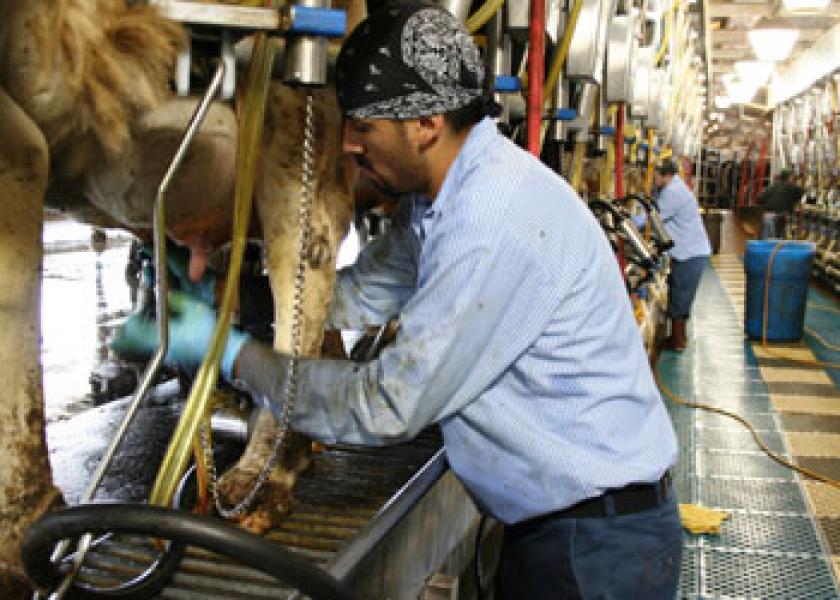Researchers Combat Illness in Dairy Workers

Dairy workers are at heightened risk of developing respiratory ailments because of particles inhaled on the job, and a group of Colorado State University researchers is using a federal grant of nearly $1 million to help find ways to protect their health.
Colorado’s dairy industry grew by about 20 percent between 2007 to 2012, when the state’s 131,000 milk cows produced more than 3.2 billion pounds of milk, according to the National Agricultural Statistics Service. The number of dairy workers that year, the most recent for which figures are available from the U.S. Department of Agriculture, totaled nearly 3,000, mostly in northeastern Colorado.
These numbers are expected to significantly climb in the next few years primarily because of demand for milk from Denver-based Leprino Foods’ huge new mozzarella cheese processing plant in Greeley, Colo.
Leading the research project is CSU’s High Plains Intermountain Center for Agricultural Health and Safety (HICAHS). The center is examining the reasons that dairy workers are susceptible to asthma, chronic bronchitis and decreased lung function — and what can be done to decrease the risk.
$900,000 grant
The three-year study is funded with a $900,000 grant from the National Institute for Occupational Safety and Health, part of the Centers for Disease Control and Prevention.
During the project, CSU researchers will work with dairies to measure respiratory responses to airborne particulates, then will design and test interventions to address those responses.
“It’s a partnership with the dairy industry on solutions that will work for them,” said Stephen Reynolds, a professor in CSU’s Department of Environmental and Radiological Health Sciences and director of the High Plains Intermountain Center.
The Colorado State team wants to identify best practices to minimize negative health effects for dairy workers, while also helping dairies to reduce costs associated with employee illness, Reynolds said.
Dairy partners
Some well-known dairy farms already have signed on to collaborate on the Colorado State research project to protect the health of dairy workers.
“We want to be proactive and support this research because we want to deal with any problems our workers may see in the future,” said Juan Velez, executive vice president of farm operations for Aurora Organic Dairy. “We believe strongly in employee well-being. So for us it wouldn’t be a problem to invest in some improvements to overall employee health. It’s the right thing to do.”
Reynolds said his center’s work with dairies since 2001 has revealed that many workers come into the industry without much experience and can be exposed to materials their immune systems are not prepared for, including dust from fecal matter, animal feed and dander, as well as chemicals used for cleaning facilities.
Dairy workers are responsible for a variety of duties that expose them to dust, including transporting, milking and caring for animals. Most workers are immigrants, young men from Mexico and Central America, and may not be well-versed in some health and safety measures, he added.
Possible outcomes
The researchers noted that some methods to reduce risk of worker illness might include simple cattle-washing practices, a change in bedding material, a different way of delivering grain, or the addition of vegetable oil to feed rations to reduce dust from manure.
“We’re engaging the dairy operators to get their input, to find out what’s the least disruptive and most economical,” HICAHS postdoctoral fellow Josh Schaeffer said.
The project also is examining the role of bacteria in the health of dairy workers. Emerging evidence suggests gram-positive bacteria may contribute to inflammation and respiratory disease in dairy workers, Reynolds said, and his team is working with biotech company Immunetics of Boston to design a quick diagnostic test for this family of bacteria.
The CSU researchers will design and test interventions, then will examine feasibility.
“This is something else we’ll be able to add to our knowledge base,” said Jon Slutsky, who owns La Luna Dairy in Wellington. “Maybe when we go to design a building there will be something new to take into consideration. I’ve always liked collaborating with the university over the years. This is just part of our process for getting better.”
The High Plains Intermountain Center for Agricultural Health and Safety is one of 10 regional centers in the United States created by the National Institute for Occupational Safety and Health to address health and safety issues in the agricultural, forestry and fishing industries. The center’s annual report is available.
Source: Colorado State University







